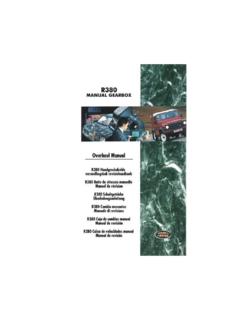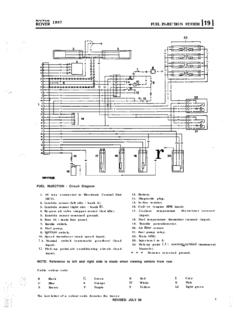Transcription of WORKSHOP MANUAL SUPPLEMENT - Land Rover
1 GED DEFENDER 90 110 130 WORKSHOP MANUAL SUPPLEMENT Publication Number SLR 621 EN WS 1 Published by the Technical Publications Department of @ Copyright Land Rover 1990 Land Rover Lode Land Sol ihul I West Midlands, 892 8NW England . Section Number 01 INTRODUCTION : CONTENTS L 04 Page GENERAL SPECIFICATION DATA .. ;,TI , $,.. ,.. ,.. 'U ..I-', 05 ENGINE TUNING DATA - General information - Poisonous substances - Fuel Handling - Sealants - Disposal of oil and fluids - Abbreviations and symbols - Special tools - Vehicle identification numbers - Copyright 06 TORQUE WRENCH SETTING - Tdi engine data - Fuel system - Cooling system - Clutch L 12 9-12 9 9 9 ENGINE 109 I RECOMMENED LUBRICANTS.
2 FLUIDS AND CAPACITIES - Tdi engine lubricants - Capacities - Anti-freeze 17 - 18 17 - ia 17 - 18 - Camshaft - remove and refit - including front cover oil seals/timing belt and gears - Power steering pump bracket - remove and refit - Cylinder head - remove and refit - Camshaft timing belt - renew - Tdi engine - overhaul 30 31 32 34 35 19 1 FUEL SYSTEM - Fuel injection pump - remove and refit - Air cleaner - remove and refit - ~ur-bo charger- remove and retit - Intercooler - remove and refit - 81 84 86 a5 ..:r :i' .. , . ,. _,. - .. Section Number I 30 Page MANIFOLDS AND EXHAUST 26 I COOLING SYSTEM e .. -7 ..- 86 ELECTRICAL EQUIPMENT - > - Engine protection - Drain and refill - Fan cowl - remove and refit - Fan and coupling - remove and refit - Radiator - remove and refit - Water pump - remove and refit 87 87 88 89 90 a8 157 I STEERING a DEFENDER INTRODUCTION INTRODUCTION.
3 I This WORKSHOP MANUAL SUPPLEMENT is designed to assist skilled technicians in the efficient repair and maintenance of Land Rover vehicles. 01 Individuals who undertake their own repairs should have some skill and training, and limit repairs to components which could not affect the safety of the vehicle or its passengers. Any repairs required to safety critical items such as steering, brakes, or suspension should be carried out by a Land Rover Dealer. Repairs to such items should NEVER be attempted by untrained individuals. WARNINGS and CAUTIONS are given throughout this SUPPLEMENT in the following form: WARNING: Procedures which must be followed precisely to avoid the possibility of personal injury.
4 CAUTION: This calls attention to procedures which must be followed to avoid damage to components. NOTE: This calls attention to methods which make a job easier to perform. REFERENCES References to the left or right hand side in the SUPPLEMENT are made when viewing the vehicle from the rear unless otherwise stated. With the engine and gearbox assembly removed, the water pump end of the engine is referred to as the front. To reduce repetition, some operations covered in this MANUAL do not include reference to testing the vehicle after repair. It is essential that work is inspected and tested after completion and if necessary a road test of the vehicle is carried out particularly where safety related items are concerned.
5 - DIMENSIONS The dimensions quoted are to design engineering specification. Alternative unit equivalents, shown in brackets following the dimensions, have been converted from the original specification. REPAIRS AND REPLACEMENTS When replacement parts are required it is essential that genuine Land Rover parts are used. Attention is particularly drawn to the following points concerning repairs and the fitting of replacement parts and accessories: Safety features embodied in the vehicle may be impaired if other than Land Rover parts are fitted. In certain territories, legislation prohibits the fitting of parts not to the vehicle manufacturer's specification.
6 Torque wrench values given in the WORKSHOP MANUAL SUPPLEMENT must be strictly adhered to. Locking devices, where specified, must be fitted. If the efficiency of a locking device is impaired during removal it must be replaced with a new one. Certain fasteners must not be re-used. These fasteners are specified in the WORKSHOP MANUAL SUPPLEMENT . PO IS 0 N 0 US SUBSTANCES Many liquids and other substances used in motor vehicles are poisonous and should under no circumstances be consumed and should be kept away from open wounds. These substances among others include anti-freeze, brake fluid, fuel, windscreen washer additives, air conditioning refrigerant, lubricants and various adhesives.
7 AS B EST0 S WARNING: Some components on the vehicle, such as gaskets and friction surfaces (brake linings, clutch discs) may contain asbestos. inhaling asbestos dust is dangerous to your health and the following essential precautions must be observed: 1. Work out of doors or in a well ventilated area and wear a protective mask. 2. Dust found on the vehicle or produced during work on the vehicle should be removed by vacuuming 3. Dust waste should be dampened, placed in a sealed container and marked to ensure safe disposal. 4. If any cutting, drilling etc., is attempted on materials containing asbestos the item should be dampened and not by blowing.
8 And on1 hand tools or low speed power tools used. 1 101 I INTRODUCTION e DEFENDER FUEL HANDLING PRECAUTIONS The following information provides basic precautions which must be observed if fuel is to be handled safely. It also outlines the other areas of risk which must not be ignored. This information is issued for basic guidance only, and in any case of doubt, appropriate enquiries should be made of your local fire station. Fuel vapour is highly flammable and in confined spaces is also very explosive and toxic. When fuel evaporates it produces 150 times its own volume in vapour, which when diluted with air becomes a readily ignitable mixture.
9 The vapour is heavier than air and will always fall to the lowest level. It can readily be distributed throughout a WORKSHOP by air current, consequently, even a small spillage of fuel is very dangerous. Always have a fire extinguisher containing FOAM CO or when dismantling fuel systems and in areas where fuel containers are stored. GAS, or POWDER close at hand when handling fuel, WARNING: It is imperative that the battery is not disconnected during fuel system repairs as arcing at the battery terminal could ignite fuel vapour in the atmosphere. Always disconnect the vehicle battery BEFORE carrying out work on a fuel system. Whenever fuel is being handled, transferred or stored, or when fuel systems are being dismantled all forms of ignition must be extinguished or removed, any head-lamps used must be flameproof and kept clear of spillage.
10 NO ONE SHOULD BE PERMWrED TO REPAIR COMPONENTS ASSOCIATED WITH FUEL WITHOUT FIRST HAVING HAD SPECIALIST TRAINING. HOT FUEL HANDLING Before commencing any operation requiring fuel drainage from fuel tanks, the following procedures should be adhered to. i 1. Allow sufficient time for the fuel to cool, thus avoiding contact with hot fuels. 2. Vent system by removing the fuel cap in a well ventilated area. Replace cap until commencement of tank drainage. FUEL TRANSFER WARNING: Fuel must not be extracted or drained from any vehicle while it is standing over a pit. The transfer of fuel from the vehicle fuel tank must be carried out in a well ventilated area.












